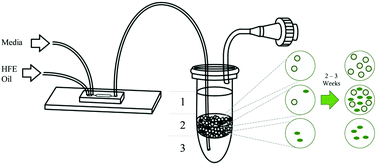Demonstration of transgressive overyielding of algal mixed cultures in microdroplets†
Abstract
Algae are ubiquitous in natural ecosystems and have been studied extensively for biofuel production due to their unique metabolic capabilities. Most studies to date have approached biofuel optimization through synthetic biology and process engineering with few industrial scale projects considering algal community interactions. Such interactions can potentially lead to increased productivity and reduced community invasability, both important characteristics for scalable algal biofuel production. It is estimated that over a million species of algae exist such that elucidating the interactions that might be beneficial for biofuel production remains extremely resource and time intensive. Here we describe a strategy for rapid, high-throughput screening of algal community combinations using a microfluidic platform to generate millions of parallel, nanoliter-scale algal mixed cultures for estimation of biomass accumulation. Model communities were first studied in a bench scale flask experiment and then examined using microfluidic droplets. These experiments showed consistent results for both positively interacting algal bicultures that increase biomass when together, and negatively interacting bicultures that decrease biomass. Specifically, these included enhanced performance of two bicultures, Ankistrodesmus falcatus and Chlorella sorokiniana, Chlorella sorokiniana and Selenastrum minutum, and reduced performance of a biculture consisting of Selenastrum capricornutum and Scenedesmus ecornis. While the ultimate techno-economic feasibility of algal bioproducts hinges on an amalgamation of scientific fields, rapid screening of algal communities will prove imperative for efficiently discovering community interactions.



 Please wait while we load your content...
Please wait while we load your content...